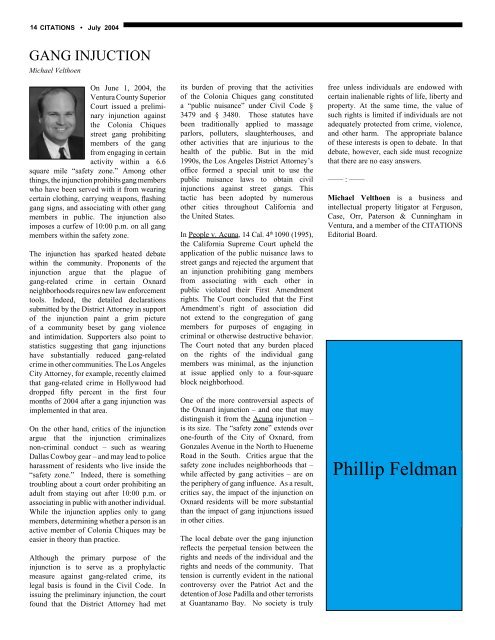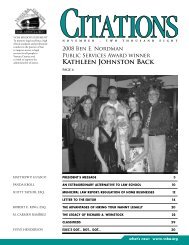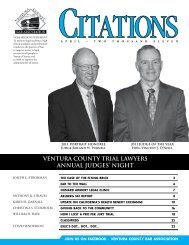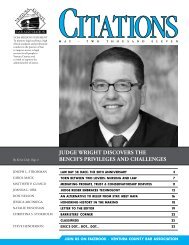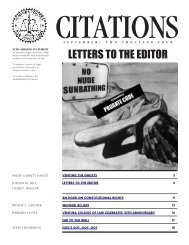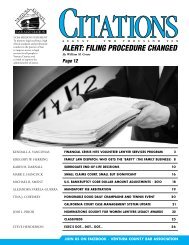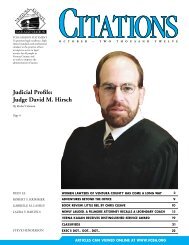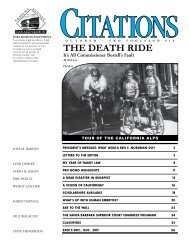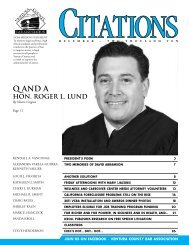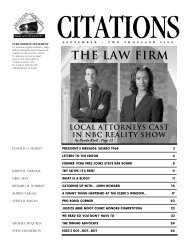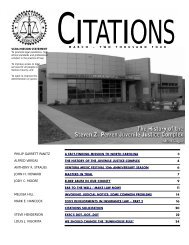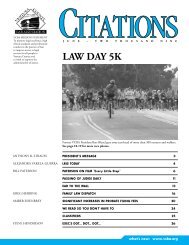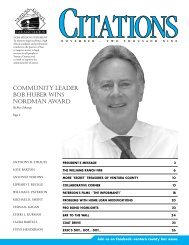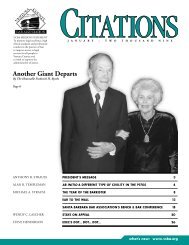Judge Frederick H. Bysshe, Jr. - Ventura County Bar Association
Judge Frederick H. Bysshe, Jr. - Ventura County Bar Association
Judge Frederick H. Bysshe, Jr. - Ventura County Bar Association
You also want an ePaper? Increase the reach of your titles
YUMPU automatically turns print PDFs into web optimized ePapers that Google loves.
14 CITATIONS July 2004<br />
GANG INJUCTION<br />
Michael Velthoen<br />
On June 1, 2004, the<br />
<strong>Ventura</strong> <strong>County</strong> Superior<br />
Court issued a preliminary<br />
injunction against<br />
the Colonia Chiques<br />
street gang prohibiting<br />
members of the gang<br />
from engaging in certain<br />
activity within a 6.6<br />
square mile “safety zone.” Among other<br />
things, the injunction prohibits gang members<br />
who have been served with it from wearing<br />
certain clothing, carrying weapons, fl ashing<br />
gang signs, and associating with other gang<br />
members in public. The injunction also<br />
imposes a curfew of 10:00 p.m. on all gang<br />
members within the safety zone.<br />
The injunction has sparked heated debate<br />
within the community. Proponents of the<br />
injunction argue that the plague of<br />
gang-related crime in certain Oxnard<br />
neighborhoods requires new law enforcement<br />
tools. Indeed, the detailed declarations<br />
submitted by the District Attorney in support<br />
of the injunction paint a grim picture<br />
of a community beset by gang violence<br />
and intimidation. Supporters also point to<br />
statistics suggesting that gang injunctions<br />
have substantially reduced gang-related<br />
crime in other communities. The Los Angeles<br />
City Attorney, for example, recently claimed<br />
that gang-related crime in Hollywood had<br />
dropped fi fty percent in the fi rst four<br />
months of 2004 after a gang injunction was<br />
implemented in that area.<br />
On the other hand, critics of the injunction<br />
argue that the injunction criminalizes<br />
non-criminal conduct – such as wearing<br />
Dallas Cowboy gear – and may lead to police<br />
harassment of residents who live inside the<br />
“safety zone.” Indeed, there is something<br />
troubling about a court order prohibiting an<br />
adult from staying out after 10:00 p.m. or<br />
associating in public with another individual.<br />
While the injunction applies only to gang<br />
members, determining whether a person is an<br />
active member of Colonia Chiques may be<br />
easier in theory than practice.<br />
Although the primary purpose of the<br />
injunction is to serve as a prophylactic<br />
measure against gang-related crime, its<br />
legal basis is found in the Civil Code. In<br />
issuing the preliminary injunction, the court<br />
found that the District Attorney had met<br />
its burden of proving that the activities<br />
of the Colonia Chiques gang constituted<br />
a “public nuisance” under Civil Code §<br />
3479 and § 3480. Those statutes have<br />
been traditionally applied to massage<br />
parlors, polluters, slaughterhouses, and<br />
other activities that are injurious to the<br />
health of the public. But in the mid<br />
1990s, the Los Angeles District Attorney’s<br />
offi ce formed a special unit to use the<br />
public nuisance laws to obtain civil<br />
injunctions against street gangs. This<br />
tactic has been adopted by numerous<br />
other cities throughout California and<br />
the United States.<br />
In People v. Acuna, 14 Cal. 4 th 1090 (1995),<br />
the California Supreme Court upheld the<br />
application of the public nuisance laws to<br />
street gangs and rejected the argument that<br />
an injunction prohibiting gang members<br />
from associating with each other in<br />
public violated their First Amendment<br />
rights. The Court concluded that the First<br />
Amendment’s right of association did<br />
not extend to the congregation of gang<br />
members for purposes of engaging in<br />
criminal or otherwise destructive behavior.<br />
The Court noted that any burden placed<br />
on the rights of the individual gang<br />
members was minimal, as the injunction<br />
at issue applied only to a four-square<br />
block neighborhood.<br />
One of the more controversial aspects of<br />
the Oxnard injunction – and one that may<br />
distinguish it from the Acuna injunction –<br />
is its size. The “safety zone” extends over<br />
one-fourth of the City of Oxnard, from<br />
Gonzales Avenue in the North to Hueneme<br />
Road in the South. Critics argue that the<br />
safety zone includes neighborhoods that –<br />
while affected by gang activities – are on<br />
the periphery of gang infl uence. As a result,<br />
critics say, the impact of the injunction on<br />
Oxnard residents will be more substantial<br />
than the impact of gang injunctions issued<br />
in other cities.<br />
The local debate over the gang injunction<br />
refl ects the perpetual tension between the<br />
rights and needs of the individual and the<br />
rights and needs of the community. That<br />
tension is currently evident in the national<br />
controversy over the Patriot Act and the<br />
detention of Jose Padilla and other terrorists<br />
at Guantanamo Bay. No society is truly<br />
free unless individuals are endowed with<br />
certain inalienable rights of life, liberty and<br />
property. At the same time, the value of<br />
such rights is limited if individuals are not<br />
adequately protected from crime, violence,<br />
and other harm. The appropriate balance<br />
of these interests is open to debate. In that<br />
debate, however, each side must recognize<br />
that there are no easy answers.<br />
—— : ——<br />
Michael Velthoen is a business and<br />
intellectual property litigator at Ferguson,<br />
Case, Orr, Paterson & Cunningham in<br />
<strong>Ventura</strong>, and a member of the CITATIONS<br />
Editorial Board.<br />
Phillip Feldman


